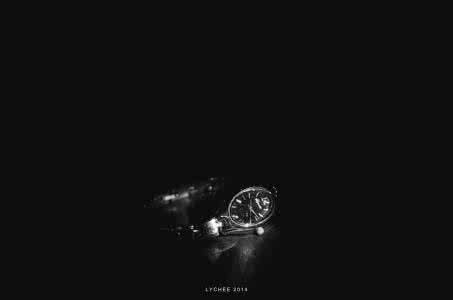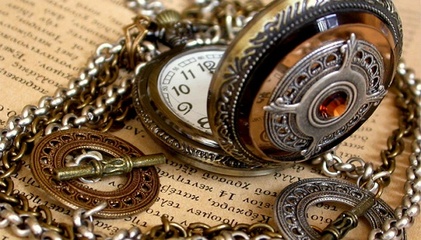时间是古老而永恒的未解之谜。奥古斯丁在北非修道院里写下他的《忏悔录》:“谁对此有明确的概念,能用言语表达出来?可是在谈话之中,有什么比时间更常见,更熟悉呢?”
译者注:奥古斯丁(Aurelius Augustinus或Augustine of Hippo,公元354年11月13日-430年8月28日)为古罗马帝国时期基督教思想家,欧洲中世纪基督教神学、教父哲学的重要代表人物,其《忏悔录》卷11探讨了时间的含义,它和亚里斯多德的时空观一起对西方时空观产生了深远影响。
十六个多世纪之后,很多学者都有这种感觉,这当然不是作为圣徒的奥古斯丁做出的预言。“我们完全不知道时间是什么,但是我们能够非常真实地感受到它的存在。”科罗拉多大学国家标准和技术研究院的物理学家克里斯·奥茨( Chris Oates)如是说。
His team operates a ytterbium optical lattice clock, one of the latest types of souped-up atomic timepieces. To track the passing seconds, such clocks rely on the fixed frequencies of photons absorbed and emitted by atoms’ electrons as they change energy levels. Recently, scientists have found ways to make these quantum counters even better, by switching from a reliance on microwave frequencies to the faster-paced optical regime and introducing a system of checks that relies on multiple atoms in levitated grids. In a remarkable recent development, the central atomic metronomes are protected from distortion by a method so powerful that physicists formally call it magic.他的团队研发了一种镱原子光晶格钟,一种最新的加强版原子钟。其原理是,当质子吸收和激发电子时,因电子的能级改变而产生的电磁波频率是固定的。最近,科学家已经发现了数种改良这些量子计数器的办法,只需将微波频段调至频率更快的可见波段,并引入基于悬浮网格的多原子格子系统。最近一项突破性进展是通过一种物理学家都正式称为“魔法(magic)”的有效方法使原子钟核心部分避免失真。
译者注:所谓光晶格钟是用激光产生“陷阱”困住数百个原子,其电子的振幅用以计时。
奥茨处于全球研究原子钟的前沿。其团队的原子钟误差为1亿年内不大于1秒。 译者注:这里用了更科学的表述,而不局限于英文原文,作为对比平常的原子钟误差为十万年内不大于一秒。
Speedy metrology快速发展的计量学
Such accuracy is why time is not just one dimension among several but a foundation for defining other fundamental units. The meter’s definition has been defined with increasing accuracy by such things as one ten-millionth the distance on a circular arc from the equator to the North Pole, and by a precision-made “prototype meter” bar of metal alloy kept in Paris. In 1983 the meter officially became the distance light will travel in a vacuum in 1/299,792,458 of a second. The better the stopwatch, the better such definitions can be applied.这样的精度解释了时间不仅是一个普通的维度,也是定义其他基本单位的基础。“米”的定义越来越精确,最初被定义为“从赤道到北极圆弧长度的一千万分之一”,并在巴黎保存了一个用金属合金精确制作的“标准米原器”。1983年“米”被正式定义为“1/299792458秒的时间间隔内光在真空中行程的长度”。计时器越精确,对米的定义就越精确。
The metrology of time is not holding still. In the April-June issue of Reviews of Modern Physics, experimental physicist Hidetoshi Katori of the University of Tokyo and theorist Andrei Derevianko of the University of Nevada, Reno declared dramatic ambitions for a record-breaking atomic clock based on emissions from mercury atoms.而对时间的度量并非一成不变的。在4月至6月召开的“回顾现代物理会议”上,东京大学的实验物理学家秀敏香取(Hidetoshi Katori )和内华达大学理论物理学家安德烈·杰列维扬科(Andrei Derevianko)表示他们(从理论上)论证了一种基于汞原子激发态的原子钟,并对其破纪录很有信心。
“If someone built such a clock at the Big Bang and if such a timepiece survived the 14 billion years, then the clock would be off by no more than a mere second,” they note in the paper. That is actually conservative. The goal formally is to lose or gain no more than one out of every billion billion seconds. That is one second in about 32 billion years, and is 10 to 100 times better than any existing clocks.“如果有人能在大爆炸时做了这么一个钟,并且能保存140亿年,其误差也不会超过1秒。”他们在论文中声称。事实上这还是保守估计。严格地说其误差为每艾秒误差不超过1秒,即大约320亿年内不超过1秒,这比目前任何钟表的精度都高10-100倍。
In scientific shorthand, the proposed mercury clock would reach a fractional uncertainty of at most one part in 1018 — it would run for 1,000,000,000,000,000,000 seconds before being one second awry.在数学缩略词中这表示汞原子钟达到了10的18次方分之一的精度,即在发生1秒的误差前它已经正常工作了 1000000000000000000秒。
Already, atomic clocks have come a long way. While experimental clocks are moving ahead, a device called the NIST-F1 is the official U.S. timekeeper. It’s accurate to a few parts in 1016. It occupies a large first floor room in Building One at NIST’s Boulder campus. The dominant feature is a shiny steel vacuum chamber 8 feet high. Inside is a laser-controlled fountain of cesium atoms chilled to near absolute zero. The atoms rise in clumps about as large as a man’s thumb and, responding to gravity, fall back through a cavity in a tunable microwave generator.原子钟“其路漫漫”。实验原子钟正在不断更新进步,美国标准计时器名叫NIST-F1,其精度达为10的16次方分之几。它占据了美国国家标准技术研究所(NIST)博尔德分部“建筑一”一楼的大块地盘。其显著特征是有一个8英尺高的钢制真空室,里面由激光将铯原子冷却到接近绝对零度。这些原子聚集成簇大得像人的拇指,在重力作用下落并经过一个装有可调微波发生器的腔体。
Oscillations within the cesium atoms are akin to the to-and-fro of the balance wheel in an old wristwatch, but it is the microwave generator that communicates with the outside world. Just as the ticking of a watch arises from the escapement mechanism connected to the gears and hands, oscillations within the cavity are recorded electronically.铯原子的振荡有点像老式手表来回摆动的摆轮,但是是通过微波发生器和外部交换信息。就如擒纵机构和齿轮、指针之间的接触使得手表发出滴答声一样,腔体内的振荡是电子化记录的。
By itself, the microwave generator would drift off time. So with each passage of the atoms, the generator checks to be sure its pulsations exactly match the signal from a chosen energy transition in the atoms’ electron clouds — an electromagnetic wave that beats 9,192,631,770 times a second.微波发生器自身会发生时间偏差。发生器要对原子的每个通道进行检查确保其振荡要和选择的电子云能量(大约是每秒振荡9192631770次的电磁波)保持精确一致。
NIST is now working on a successor, called F2. With an improved cooling system and superior way of moving the atoms through the microwave chamber, it will be about four times better and will beat out the current record for a long-term timekeeper, a clock in the United Kingdom that is accurate to about two parts in 1016.NIST正在研制其后继者,称为F2。随着冷冻技术的进步和用微波腔移动原子的便捷性提高,F2的性能将提高大约4倍,并且将打破目前英国原子钟长期保持的10的16次方分之2的记录。 时过“时”迁:过去一千年里计时器的精度发生了翻天覆地的进步,过去中国水运仪象台一天的误差达到10分钟,而最近五年科学家期望制造出从宇宙大爆炸至今都不会产生大于1秒误差的原子钟。图表的具体信息没有翻译,我们只需要知道计时器的精度在这一千年里的变化趋势就行了。
Such astonishing accuracy is no mere intellectual exercise. Recent advances in timekeeping have brought practical payoffs in the design of better global positioning systems that triangulate locations on Earth by measuring distance via radio-signal travel time, as measured by satellite-borne atomic clocks. Further progress should lead to instruments able, from the slowing or speeding of time’s passage due to shifts in gravity, to improve maps of the planet’s interior and to find mineral deposits or detect the movements of deep magma. Pure research on Earth and in space may gauge to almost unimaginable exactness the stability (or drift) of supposed constants of physics that not only affect nuclear decay, but also, some astronomers say, may have worked differently in distant eras.这样惊人的精度不仅仅是吃饱了没事干,最近计时器的进步为设计更好的全球定位系统奠定了基础,定位的依据就是通过星载原子钟计算无线电信号在一定时间里运动的距离,将地球分为若干个三角形区域。计时器的进一步发展可以导致探测仪器的进步,比如测量由于引力变化导致的时间加快或减慢,行星地质地图的细致化,寻找矿床或者探测深层岩浆的移动。一些天文学家表示,对地球和宇宙的纯理论研究表明物理常数难以想象的稳定性(或发生偏移)并不单只影响核衰变,也可能在遥远的过去发生不同作用。 译者注:常用的物理常数构成了所谓的精细结构常数,倘若其值大一点点或者小一点点都会使得宇宙在大爆炸后向不同的方向发展,那样的话,不要说没有人类,有没有地球,能不能形成重元素都是个问题。
Ticking gears疯狂的时钟
By historic standards, clock progress is now frenzied.从历史上看,现在钟表的进步简直可以用疯狂来形容。
People have long kept track of time by monitoring processes that change measurably in a steady way. Early peoples monitored the seasons by the motion of the sun and moon. An 11th century Chinese water clock, its gears driven by a steady stream, might lose or gain 10 minutes a day — an accuracy of about a part in 100. Large, stable swinging pendulums in the 1600s were good to a few seconds a day. Eighteenth century navigation clocks that were the pride of the British Navy weren’t much better. They lost or gained a minute or less per month, an accuracy of about one in 10,000, but they did it while tossing about in ships at sea. Quartz clocks and watches, paced by electrically stimulated crystals vibrating at about 32,768 times per second, were developed in the late 1920s. They keep time to within a second per day, better than a part in 105.人们长期以来都是通过监控某个恒定可测的变化过程来记录时间的。早期人类通过太阳和月球的运动来区分四季。11世纪的中国水运仪象台,其齿轮由恒定水流驱动,一天里的误差为10分钟,即精度大约为百分之一。17世纪大而稳定的摆钟一天的误差缩小至几秒。18世纪英国皇家海军引以为傲的航海钟并没有更好到哪去。它们每月的误差为1分钟,即精度约为万分之一,但是它们是应用在呼啸的大海上的。20世纪20年代发明了石英钟表,其原理是石英在电力激发下会发生晶体振动,大约每秒32768次。其误差为每天小于1秒,即比万分之一强些。
译者注: Chinese water clock最初以为是刻漏,但是并非11世纪才有,也没有齿轮,个人倾向于水运仪象台,一种纯机械耦合的计时器,欢迎大家批评指正;摆钟和航海钟的原理一样,都是运用伽利略发现的“摆的等时性”,1657年惠更斯发明了世界上第一个摆钟,1728到1759年,航海钟问世;石英钟表用的是所谓的逆压电效应,目前最好的石英钟精度为十万分之一。
伴随着量子力学的横空出世,核子与电子间的作用法则被揭示,之后就轮到原子钟独领风骚了。自1949年首个原子钟(以氨分子为磁振源)面世以来,原子钟的精度每十年就几乎提高十倍。近年来,其增速更快了。
译者注:这是目前世界上已造的最精确的时钟,是英国制造的,1.38亿年误差不大于1秒。
诸如NIST-F1的仪器运用的原子信号是频率为数十亿赫兹的微波,新式时钟包括奥茨的都是运用频率快上百万倍的光。NIST时间与频率部及量子物理部的负责人汤姆·布莱恩表示新方法就好比“有了一把精确度更高的尺子”,“其发展速度真是和坐火箭一样。”

A further development, the lattice clock, has been imagined only in the last decade, with rapid progress in the last five years. For now, related devices called single ion optical clocks, which key in on solitary electrically charged atoms such as aluminum, are the most accurate. However, lattice clocks’ use of many atoms simultaneously, with a strong combined signal, appears to give these clocks the ultimate edge.
进一步发展的晶格钟是在过去十年才被构想出来,在过去五年取得了实质性进展。目前将这种网格装置称为单离子光学钟,其关键在于孤立带电原子比如铝,它们的精度最高。但是晶格钟通过一个强信号同时操纵多个原子,使得它们有一个终极边界。
Katori says his team in Tokyo hopes to have the first clock with one part in 1018 accuracy working within five years. A look at how the record-setting mercury clock would work reveals the basics of all contemporary neutral-atom lattice clocks.香取说其在东京的团队希望在五年内制作出首个精度达到10的18次方分之一的原子钟。通过观察这个汞原子钟是如何工作的将奠定目前所有中性原子晶格钟的基础。
At a glance, the proposed clock is a bewildering laser beam jubilee — but there is underlying order.乍看上去这个目前仍停留在纸上的时钟就是一簇眼花缭乱的激光束聚在一起过节,但是其本质是有序的。
The action starts with a system of cooling lasers that bathe a thin vapor of mercury atoms in what is called “optical molasses” to slow their motion. Temperatures hit a few millionths of a degree above absolute zero, a coolness at which each atom drifts roughly at the walking speed of ants. But even at that slow speed, the motion causes a slight blur in the atoms’ collective optical signals.通过冷激光系统给汞蒸气“洗冷水浴”减缓汞原子的运动使其成为所谓的”光学粘团(optical molasses)”。温度可以达到只比绝对零度高百万分之几度,使得每个原子的运动都像蚂蚁爬一样慢。但是即便是如此慢的速度,其运动仍将引起原子团光信号的轻微模糊。
译者注:在热力学定义中,绝对零度即所有原子/分子都不动了,即没有了无规则热运动,这是个理想极限条件不可能达到,只能无限接近,但是一旦有了热运动,即便很小,都可能产生干扰信号。
冷激光将冷却原子推入一个存在互相垂直激光的区域。互相作用的光波(有时可以通过镜像系统达到增强)形成一个小型三维能量场。
This is the lattice. Its standing waves rise and fall but do not propagate. When the fields’ energies are diagrammed, they take on a pattern that looks a bit like the hollows in egg cartons. These nodes trap and hold the atoms — ideally one atom per energy well — in perfectly aligned ranks. The entire array of atoms is levitated in a tiny near-vacuum about 100 micrometers across, roughly the thickness of a page in a glossy magazine like this one. Most important, the trapping lasers whose beams produce the lattice will be set to a “magic frequency” — a recent breakthrough in the field — to grip the atoms in place while not distorting the shapes of their electron clouds.这就是所谓的“晶格”。它形成了起起落落的驻波但是并不传播。当能量场被绘制出来时,它看起来有点像凹下去的蛋箱。那些凹下去的节点就好像陷阱能抓住原子(理想状态是一个能量阱一个原子),且所有的陷阱都完美地在同一级别上。完整的原子阵列悬浮在一个微小的近真空环境中,大约100微米长宽,厚度大概是一页杂志的厚度。最重要的是,用以俘获原子形成网格的激光束被设置在了一个“魔法”频率,快要突破场的极限但能陷住原子同时不改变其电子云分布。
译者注:lattice原意的确是晶格之意,optical lattice clock之所以翻译成光晶格钟,其重点不仅在于形成了网格,而更重要的是其微观量子效应,如文所述,数量级为微米级别,和通常所说的晶格是同一数量级。
以上才代表关键步骤刚刚开始。原子钟所用激光(频率比1赫兹快些)照射在原子上,让原子调整自身以匹配其吸收或激发激光的最佳频率。激光具有良好的光学精密性和单色性。但是在这个原子钟的装置里,它们还是太不稳定了不能靠自身确保时间。因此用原子节拍器对其调节使其有序,就好像教官喊节拍一样。
Just one more big step: reading the clock. Though this clock relies on visible light, optical waves flicker far too fast, nearly a million billion times per second, for electronic circuits to count one by one. So, the clock laser is keyed in turn to yet another recent invention, what’s called an optical comb laser. It is many thousands of lasers in one. Its multiple wavelengths, when plotted, look like the teeth of a comb, stretching across a vast frequency range. Optical combs were a big reason another scientist at NIST, John Hall, shared a Nobel Prize in 2005.下一个重要步骤是:读取时间。尽管原子钟用的是可见光,光学波频率很大,接近1拍赫兹,而电子线路是一个一个计数的。所以还应用到了另一项最新技术,即所谓的“光梳(光频率梳)”。它是数千束激光集合在一起,自然就有多种波长,将它们绘制出来看起来就像梳子的梳齿一样,涉及的频谱也很宽广。光梳也是NIST另一科学家约翰·霍尔(John Hall)和另外两位科学家共享2005年诺贝尔物理学奖的一个重要原因。
The comb’s function is akin to a transmission’s gears. By synchronizing one of the optical teeth with the clock laser, atomic clockmakers force the other teeth to become equally stable. That way one of those in the microwave domain can be selected to deliver a countable beat, a million times slower.光梳的作用和传动装置中的齿轮一样重要。通过将激光和光梳某个梳齿同步,制作者可以使得其他梳齿变得同样稳定。这样的方法在微波领域能用来减慢光频率一百万倍,使得其变得可测量。
Now, a pause to ponder magic. By the 1990s it was clear that laser lattices would allow a probe laser to gaze at a throng of trapped atoms long enough to get a better reading on their signal than is possible with a fountain clock such as the F1. The lattice would also prevent collisions among the atoms, a key source of distortion in microwave fountain clocks.现在我们停下来思考一下所谓的“魔法”。20世纪90年代人们就已经知道激光网格能让探测激光在足够长的时间里陷住一大群原子以便能获得比F1那种喷泉钟更准确的信号。同时网格能避免原子间的互相碰撞,而这是喷泉钟产生微波信号干扰的关键原因。 译者注: fountain clock喷泉钟,顾名思义就是以原子喷泉为原理的原子钟,比如文中提及的F1,为何叫喷泉呢?文中也提到,将原子上抛和下落过程中要经过谐振器,这个上抛和下落和喷泉相似,物理学家因此命名。
However, lattices come with a price. Their oscillating electromagnetic fields typically and severely distort atomic energy levels. One can easily guess how badly a violin would go off tune if someone squeezed its belly and twisted its scroll just as the violinist was striving for a delicate note.可是网格造价昂贵,而所需的振荡电磁场严重的扭曲了原子能级。我们不难想象一个小提琴共鸣器受到挤压、琴弦受到扭曲时后果有多糟糕,所以小提琴手对此都很注意,原子钟也一样。
In 2001, Katori and colleagues began publishing proposals that there might be a cure. Perhaps there could be certain frequencies of trapping fields that would displace the boundaries of one key energy transition by exactly the same degree. Katori’s insight, bolstered by calculations by Derevianko and others, offered a way to grab that violin roughly yet leave one selected note unwavering.2001年香取及其合作者开始研究解决办法。也许俘获场的某一频率能同等程度地代替一个关键能级跳跃的阀值。香取的观点被杰列维扬科和其他人的计算证实了,他们提供了一种能够抓住“小提琴”而不改变其音质的方法。
In conversations with Katori, Nobelist Hall said such frequencies sounded like magic. Some journal editors initially resisted when formal papers referred to magic. But the name stuck.霍尔在和香取交谈时谈到这样的频率听起来就像魔法。当正式论文提及“魔法”时一些杂志编辑起先还很反对呢。但是这个名字还是保留下来了。
Magic frequencies give lattice clocks accuracy a billion-fold better than they would otherwise manage. “That is nine orders of magnitude,” Derevianko says. “That is magic happening.”魔法频率使得晶格钟比其他形式的原子钟精确十亿倍。“那可是九个数量级呢,”杰列维扬科说,“可不就是魔法啊。”
Katori calls it “a gift from nature.”香取则称它是“大自然的礼物”。
With magic frequencies soon discovered for several atoms suitable to trapping in lattices, physicists now had an army of atoms, says Jun Ye of JILA, an institute that NIST and the University of Colorado operate jointly. “A million-man army is better than a one-man army.”魔法频率能很快发现一些原子适合被晶格俘获,物理学家现在有了一支原子军队,JILA (NIST与科罗拉多大学联合建立的实验天体物理实验室)的叶军如是说,“一百万人的军队就是比一个人的军队好。”
译者注:叶军(Jun Ye)专访看这里:http://www.chinanews.com/hr/hrgs/news/2007/08-29/1013472.shtml
叶的团队研发了锶原子晶格钟。2007年通过光学纤维他将他的原子钟和NIST奥茨的钙原子晶格钟连接起来。两位研究者就可以以10的16次方分之一的精度反复核对时间,这证明这样的原子钟可以通过电学和光学电路连接起来。
Beyond the tock滴答声的背后
Such advances are the latest step in humankind’s ancient drive to measure how long it takes things to happen, whether for a season to pass or an automobile equipped with GPS navigation to drive 10 feet as monitored by the changed time for a radio signal to reach and return from two distant satellites whose locations are known. A one in 1018 clock would allow location to a matter of inches — on Mars using satellite transceivers at Earth.如此的进步是人类从古至今试图测量时间的最新进展,无论是季节的变迁还是装有GPS导航的汽车都离不开时间的变化,后者即是根据两个已知位置的远距离卫星来回收送无线电信号来确定的。比如火星和地球各有一个卫星收发无线电,则一个精度达到10的18次方分之一的原子钟就可以帮忙定位到英寸大小的物体。
The European Space Agency aims to make the International Space Station a platform for fundamental discovery with lattice clocks. That agency, along with the French space agency, has already begun a mission called ACES, or Atomic Clock Ensemble in Space. Its aim is to install on the space station a laser-cooled cesium microwave clock, with accuracy of about one in 1016.欧洲航天局(ESA)想通过使用晶格钟使得国际空间站成为一个基础研究的平台。欧洲航天局和法国太空署已经开始了一项名叫ACES的项目,全称是“Atomic Clock Ensemble in Space(原子钟组合在太空)”(译者注:一般直译为“太空钟”)。其目的是在空间站组装一台精度为10的16次方分之一的激光冷却铯原子微波原子钟。
Linking to ground clocks based on different atoms and atomic transitions in a worldwide network, the timekeeper will probe fundamental laws of physics to high accuracy, says Luigi Cacciapuoti of ESA’s astrophysics and fundamental physics division. Under scrutiny will be such esoterica as the constancy of the speed of light in all directions, and Einstein’s equivalence principle declaring that gravity and acceleration have the same effects on time and physical processes. With shuttles retired, the first such clock could be delivered by a Japanese or other automated transfer vehicle as early as 2014.ESA天文物理和基础物理部的路易吉·卡恰波蒂(Luigi Cacciapuoti)表示,如果将太空钟的原子钟与地面各种基于不同原子和原子跃迁的原子钟纳入一个全球范围的网络,那么计时器就使得人类可以以高精度探测物理基本定律。比如我们可以在各个方向上验证光速是否是恒定不变的,爱因斯坦的等效性原理认为重力场与以适当加速度运动的参考系是等价的(无论是时间上还是物理过程上)。随着航天飞机的退役,首个这样的原子钟最早将于2014年将通过日本或者其他自动运载飞船运往国际空间站。
译者注:这里用的等效原理为弱等效原理,详见:http://zh.wikipedia.org/zh-cn/%E7%AD%89%E6%95%88%E5%8E%9F%E7%90%86
杜塞尔多夫·海因里希·海涅大学(简称杜塞尔多夫大学,位于德国杜塞尔多夫)的斯蒂芬·席勒(Stephan Schiller )极其合作者正在进行一项名叫“太空光学钟(Space Optical Clocks)的项目,希望在2020年左右建成一个精度比目前高10倍的光晶格钟。他们期望将地球引力场引起的相对论效应和太阳的相对论效应相比较。一些理论认为地球由于拥有铁质核心和其他重元素物质,将略微影响时间通道使得它和轻元素(主要是氢)组成的太阳表现出不同的相对论效应。
Can timekeeping possibly continue a tenfold improvement every decade? There are many orders of magnitude before timekeeping would reach the smallest increment allowed by known physics — called the Planck time, 10-43 seconds. To even approach it seems out of reach.计时器真的能每十年提高十倍吗?在计时器达到物理学允许极限(即所谓的普朗克时间,10的负43次方秒)之前仍有很多个数量级的精度可以提升,甚至它就很难达到。
As for boosting precision relatively modestly by bringing today’s atomic lattice clocks into ultraviolet or even X-ray domains, several technical hurdles stand in the way.至于通过将今天的原子晶格钟引入紫外甚至X射线频段以提高精度,目前仍有数个技术难题有待解决。
译者注:紫外和X射线是高频射线,能量更高,意味着电磁波波长更短频率更高,实际上目前对时间秒的定义即是”铯133原子基态的两个超精细能阶间跃迁对应辐射的9192631770个周期的持续时间,所以高频有利于提高精度。
原子钟原理是基于原子外层电子的运动,也许有其他方法来振荡,比如核反应。在原子核内,中子和质子堆叠在一起,同样也根据量子力学互相交换能量。举例来说,计算表明,钍-229的原子核内存在着能发出紫外线的转变过程。如果那个信号能被加强,受激放大,一个激光频率梳可能对其锁定并产生一个更低频率的振荡使得电子计数器能够计数。
“This is a very important development, as the nuclei are very well isolated from external perturbations,” says Derevianko. It may open a path “toward the ultimate clock.”“这是一个十分重要的进步,因为原子核和外界扰动很好的隔绝开了。”杰列维扬科说。这或许开拓了一条“通往终极时钟”的道路。
Only time will tell.这只有交给时间去证明了。
A laser jubilee激光乱舞
From the outside, a lattice clock appears to be a dizzying array of lasers, but (as shown in one type of strontium clock at right) each laser has a role in reading the time from atomic oscillations.从外面看,一个晶格钟看起来是一系列眼花缭乱的激光,但是(如展示的锶原子原子钟)每束激光都有各自的作用,用以从原子振荡中读取原子时。
Thousands of strontium atoms are cooled by a system of blue lasers.数千个锶原子被蓝激光冷却。
Red lasers further cool and shrink the cloud of atoms.红激光进一步冷却并缩小原子云区域。
An infrared laser system traps the atoms, locking them into pancake-shaped wells.红外线激光俘获原子,将它们陷在晶格阱中。
Another red laser, the “clock” laser, bathes the atoms, causing many of them to become excited.另一束红激光,所谓的“时钟”激光,将给原子“泡澡”,使它们受激。
A blue laser probes the cloud; emitted light reveals how many atoms became excited.一束蓝激光探测电子云,受激光显示有多少原子受激发。
The clock laser adjusts to properly keep pace based on the atoms’ excitations. Light from the clock laser is passed through a “frequency comb,” allowing the light’s ticks to be read.时钟激光和受激原子保持频率一致。时钟激光通过一个频率梳,使得光能够被读出。
 爱华网
爱华网


